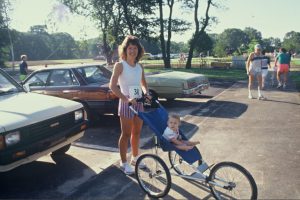The Physical Activity Guidelines Advisory Committee is composed of 17 nationally recognized experts in the fields of physical activity and health. These distinguished individuals agreed to serve on the Committee in a voluntary capacity to review current evidence and make recommendations that will help inform the next edition of the Physical Activity Guidelines for Americans. This post is part of a series of interviews with the Committee members to learn more about the men and women providing independent expertise and service to improve the health of the Nation.
Today, we are highlighting Dr. Linda Pescatello, Distinguished Professor of Kinesiology at the University of Connecticut in Storrs. On the Committee, Dr. Pescatello serves as the as a member of the Cardiometabolic Health and Weight Management and Individuals with Chronic Conditions Subcommittees.

What led to your interest in physical activity?
Both of my parents influenced my interest in physical activity. My mother was a nurse with a passion for biology and the health benefits of an active lifestyle and my father was a Minor League baseball player. After graduating with a bachelor’s degree in biochemistry, I taught high school biology and chemistry classes and coached basketball and track. While teaching I decided to pursue a master’s degree in exercise science which combined my love of science and admiration of sport. During an internship at a cardiac rehabilitation facility at a local community hospital, I was introduced to the work of Dr. Charles Leach, a pioneering preventive cardiologist in the use of ambulatory blood pressure monitoring to diagnosis hypertension in his patients. His use of ambulatory blood pressure monitoring inspired my research, which focuses on physical activity as the mechanism for prevention of cardiovascular disease, particularly hypertension.
Tell me about some of your recent research
Since 1998 my research has focused on the acute effects of exercise on blood pressure. For most people, their blood pressure is lower on the days when they exercise compared to the days they do not. In fact, if you were to measure your resting blood pressure, take a walk, and measure it again afterwards, it would be lower throughout the remainder of the day. It is important to emphasize that this is a good thing. It means people who have hypertension can lower their blood pressure to normal ranges and sustain that reduction with exercise for the daytime hours when blood pressure is typically at its highest levels. When we first began studying this relationship we hypothesized that moderate exercise was best. Now we know that, in fact, with greater exercise intensity we see greater blood pressure reduction.
In my role as the associate editor of the 8th edition of the American College of Sports Medicine (ACSM’s) Guidelines for Exercise Testing and Prescription, and senior editor of 9th edition, I contributed to framing the exercise recommendations made by the College with the F.I.T.T. principle (frequency, intensity, time, and type) of exercise prescription. I feel privileged to have been named an editor of ACSM’s Guidelines for Exercise Testing and Prescription because of the impact and scope of the Guidelines have in the way research about the health benefits of exercise is disseminated to the public. In my work I also study the interplay between blood pressure, genes, and race/ ethnicity termed exercise genomics
If you had a magic wand to change one thing related to physical activity, what would you change?
I would make every town walkable. My town has sidewalks, but just one town over there are none. Americans should be able to incorporate physical activity in their day-to-day life so that as a society we become more active. On a recent trip to the Netherlands I was struck by the numerous bike paths and pedestrians walkways that exist there which make physical activity part of daily life.
What tip would you give Americans who are trying to be more physically active?
Get a dog! Seriously, I know people who take twice-daily walks because they are concerned with the health of their dog. I would encourage Americans to find physical activities they enjoy. The best type of exercise is the type you enjoy the most, because it is achievable and you are more likely to stick with it.
~
The Office of Disease Prevention and Health Promotion would like to personally thank each of the members for their dedication and service on the Committee. The Committee’s independent review of the scientific literature is the result of thousands of hours of work and will culminate with the submission of the 2018 Physical Activity Guidelines Advisory Committee Scientific Report to the Secretary of the Department of Health and Human Services (HHS). HHS will use the report to develop the next edition of the Physical Activity Guidelines for Americans.